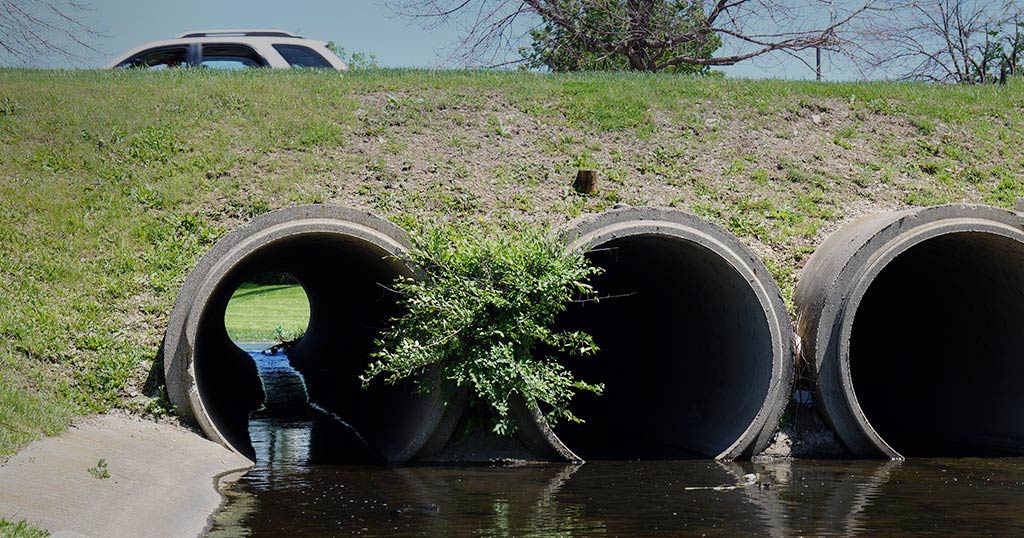Circular pipe culverts are widely used in building projects. Do you know the equations that relate pipe culvert parameters under the condition of inlet control, or outlet control? Learn the equations in this article.
Editor’s Note: Harlan Bengtson is retired after a 30 year career as a university professor (engineering science and environmental engineering) and administrator. He is currently active as owner and manager of two websites created to make available low cost, easy to use spreadsheets for a variety of civil engineering and mechanical engineering calculations. The websites are www.EngineeringExcelTemplates.com and www.EngineeringExcelSpreadsheets.com.
Circular pipe culverts are widely used in transportation applications to transport stormwater under roadways, railways, etc. Corrugated metal and concrete are used for many of these pipe culverts. Major design parameters for culvert design are the diameter and slope of the pipe for a specified culvert material.
Inlet Control and Outlet Control for Pipe Culvert Design Calculations
The two main approaches used for pipe culvert design are inlet control and outlet control. In the case of inlet control, the flow rate through the culvert is controlled by the conditions at the inlet to the pipe, including the diameter of the culvert. In the case of outlet control, the flow rate through the culvert is controlled by the conditions at the outlet from the culvert and/or the friction loss though the bore of the culvert. These two approaches to pipe culvert design and the conditions under which each should be used are discussed in the next two sections.
Inlet Control – Pipe Culvert Design Equations and Calculations
The following equation that relates pipe culvert parameters under condition of inlet control comes from the U.S. DOT/Federal Highway Administration publication shown at the end of the article.

The parameters in the equation are as follows:
HW is the headwater depth above the invert at the inlet in ft (m for S.I. units).
D is the inside height of the pipe culvert in fr (m for S.I. units).
Q is the design discharge through the culvert in cfs (m3/s for S.I. units).
A is the cross-sectional area of the culvert in ft2 (m2 for S.I. units).
S is the culvert slope, which is dimensionless.
K1 is the 1.0 for the U.S. units shown in this list and is 1.811 for S.I. units.
Ks is a slope constant, which is – 0.5 for a non-mitered inlet or + 0.7 for a mitered inlet.
Y and c are constants that are dependent upon the type of inlet and type of culvert.
A check on whether inlet control or outlet control applies for a given culvert configuration and flow rate can be made using the parameter, Q/(AD0.5). If this parameter is greater than 4 for U.S. units or greater than 2.2 for S.I. units, then inlet control is applicable and the equation above can be used to determine the required pipe culvert diameter for specified design flow rate, maximum allowable headwater depth, culvert slope, and information about the type of culvert and type of inlet.
Note that this equation can’t be solved explicitly for culvert diameter, D, so some type of iterative solution is required. This makes an Excel spreadsheet a good choice for carrying out the calculations.
Outlet Control – Pipe Culvert Design Equations and Calculations
The following form of the Manning equation for open channel flow under gravity, relates pipe culvert parameters under the condition of outlet control. It comes from the U.S. DOT/Federal Highway Administration publication shown at the end of the article. This equation is appropriate to use if Q/AD0.5> 4 for U.S. units or if Q/AD0.5> 2.2 for S.I. units.-

The parameters in the equation are as follows:
hL is the head loss in the culvet barrel when it is flowing full, in ft (m for S.I. units).
Ku is a constant equal to 29 for the U.S. units shown here or 19.63 for S.I. units.
N is the Manning roughness coefficient for the culvert material. It is dimensionless.
L is the length of the culvet barrel in ft (m for S.I. units).
R is the hydraulic radius of the culvert barrel when it is flowing full in ft (m for S.I. units). Note that R = A/P, with A and P as defined below.
A is the cross-sectional area of flow for the culvert barrel in ft (m for S.I. units).
P is the perimeter of the culvert barrel in ft (m for S.I. units).
V is the velocity of flow in the culvert barrel in ft/sec (m/s for S.I. units).
(Note that V = Q/A.)
Ke is the loss coefficient for the type of pipe entrance being used. It is dimensionless.
Note that this equation also cannot be solved explicitly for the culvert diameter, D, so an iterative solution is needed. An Excel spreadsheet also works well for this solution.
Summary
Equations were presented to allow determination of required pipe culvert diameter for conditions of either inlet control or outlet control. The culvert parameters needed to determine the culvert diameter under inlet control conditions are: design flow rate, maximum allowable headwater depth, culvert slope, type of culvert material and type of inlet. For outlet control the same parameters are needed plus the length of the culvert.


